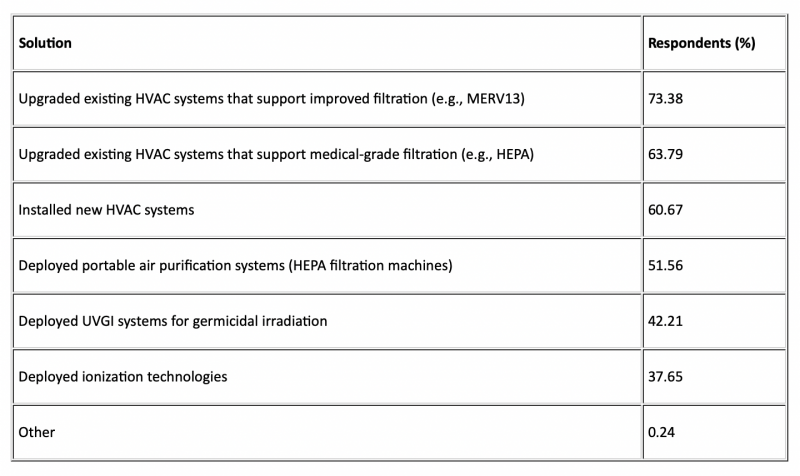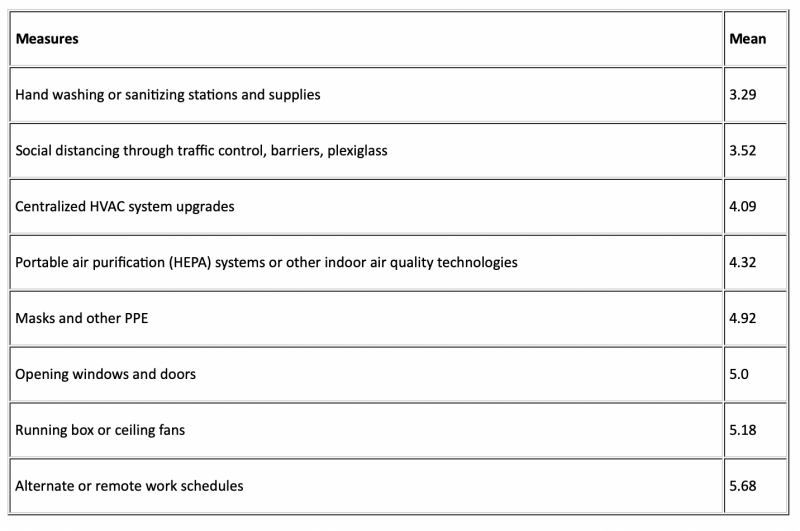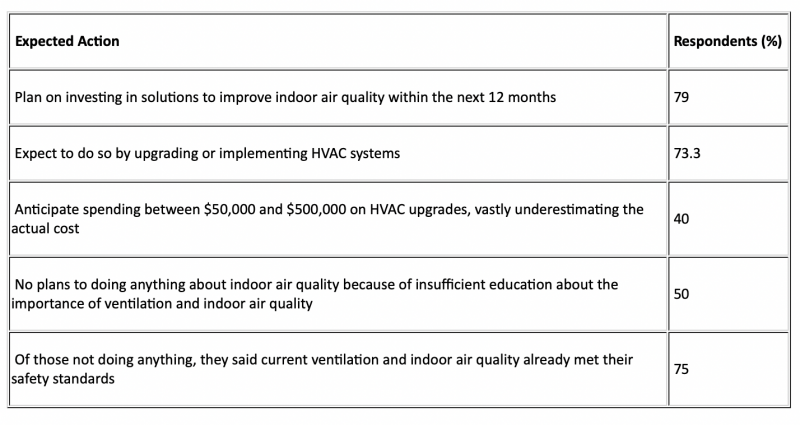A new survey commissioned by Omni CleanAir, a maker of commercial-grade air purification systems, found that while 95.6 percent of companies tried to combat COVID-19 transmission in poorly ventilated indoor spaces, they often made subpar investments.
“We polled more than 430 HR managers around the country on the importance of various COVID-19 precautions and defense measures, their knowledge of indoor air quality topics, and their budgets and spending forecasts,” said Paul de la Port, president of Omni CleanAir. “In the past year, almost every business surveyed took some action to improve indoor air quality, but while organizations invested hundreds of thousands (in some cases millions) of dollars, measurable results are lacking.”
The nationwide survey, conducted by Pollfish in April and May, consisted of an online survey of 436 HR managers of companies with 500 or more employees. The margin of error was +/- 5 percent, with a confidence level of 95 percent.
Steps Taken
The most popular approach by businesses was to upgrade existing heating, ventilation and air conditioning systems—a change that can be implemented quickly and easily. However, HVAC upgrades typically cost more than $500,000, and in some cases as much as $5 million depending on the number and size of the facilities. Additionally, for an upgraded HVAC system to improve air quality, it must operate continuously while the building is occupied, which can be expensive. In other cases, businesses tried relatively new ionization technologies, which are increasingly under attack from academics and government agencies for being ineffective and possibly dangerous.
“The noisy environment, lack of transparent and easily understood real-world efficacy data and unscrupulous COVID-19 opportunists appear to have clouded the landscape so much that many businesses simply were unable to make informed investment decisions about indoor air quality solutions,” de la Port said.
When asked what kind of improvements were made within the last 12 months, respondents revealed the following trends:

Cost, Efficacy of HVAC Solutions
Survey data also show that HR managers and their COVID-19 task force colleagues are vastly underestimating the cost of HVAC upgrades. Among those who have not yet invested in solutions to improve indoor air quality, a majority anticipate they will upgrade their HVAC systems despite the growing evidence that these upgrades have minimal effect on improving indoor air quality or reducing transmission risk.
“What many businesses don’t realize is that HVAC systems, even when they can eliminate the virus, require large amounts of electricity to operate, so the long-term cost will be very burdensome and the resulting air often won’t be adequately cleaned,” de la Port said.
Perceived Importance of a Variety of COVID-19 Solutions
When asked to rank the following measures in order of most important (1) to least important (8) for combating COVID-19 in their organization, HR managers, in aggregate, revealed how they prioritize the following items:

“It’s clear from the survey that HR and facilities managers struggled to sift through the COVID-19 noise to determine the best options for combating the virus and while most recognized that it is airborne, the best solution to fighting it remains unclear,” said de la Port. “For example, we know that you only have a 1 in 10,000 chance of getting infected via a contaminated surface, yet it’s at the top of the list of things businesses have done and are continuing to do to fight COVID-19.”
Businesses Planning Indoor Air Quality Spending in the Next Year
Of the survey respondents whose businesses hadn’t yet taken actions to improve indoor air quality most indicated they would allocate spending to ventilation in the next year. Of those who said they would do nothing, they cited lack of education and information, as well as satisfaction with current air quality standards in their facilities. Here is the breakdown:

